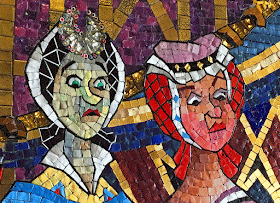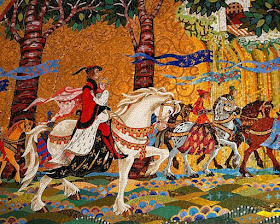
 The different take on Cinderella is an intriguing use of a very familiar fairy tale to highlight and explore a specific social issue, too; one that not only speaks directly to and for the deaf community, for whom it was created, but for anyone considered 'different'. It's a tale all too relevant and has something for everyone.
The different take on Cinderella is an intriguing use of a very familiar fairy tale to highlight and explore a specific social issue, too; one that not only speaks directly to and for the deaf community, for whom it was created, but for anyone considered 'different'. It's a tale all too relevant and has something for everyone.Yes - you read correctly: this is a musical for deaf and hearing people to enjoy equally. (Yahoo)
“Stepchild,” (is) a musical that combines songs, spoken word and American Sign Language... (and aims) to make every aspect of the show accessible and meaningful to Deaf and hearing audiences alike.Here's the premise:
Interview excerpts (combined from 2 interviews - apologies for the odd-formatting!):
Loosely based on the classic fairy tale Cinderella, “Stepchild” tells the story of Orella, a deaf girl coming of age during the Italian Renaissance. She and her widowed father Massimo struggle to eke out an existence as street performers until their shadow puppet shows attract a wealthy benefactor, the kingdom’s young prince Luca. As Orella’s father seeks out stability by courting Antonia, a widow with two daughters, Orella encounters Allegra, a mysterious fortune-teller who is also deaf and teaches her how to communicate using sign language.
Orella discovers a joyous new world, but when she tries to teach others in the community about sign language, she attracts the ire of the ignorant and fear-mongering King, who ruthlessly punishes anyone that dares to embrace what makes them “different.” After an unimaginable tragedy, Orella finds herself fighting for her life, and must find the courage to combat the darkness and liberate her kingdom from oppression.

Although “Stepchild” is a fairy tale set long in the past, how does it shine a light on the discrimination Deaf people experience today?
“As we began delving into our research and outreach to the Deaf community, we uncovered a dark and at times brutal history for people with disabilities. The widespread disregard and common violence against many Deaf and differently-abled people is a heartbreaking truth left out of our high school history books. So we set out to create a full-length musical theater piece with the gravity of this dark historical past and the weight of mankind’s propensity for vilifying ‘the other’ as our dramatic base... — David James Boyd and Chad Kessler, Creators of “Stepchild”
“As have other ethnic groups and cultures, the Deaf have had to fight for the existence of and the right to their language. The deprivation of language acquisition is political and abusive. Political because it is about control and abusive because of the severe psychological, emotional and social harm it does to the individual.” — Kim Weild, Hearing Director
Why is the tale of Cinderella the right choice for your specific adaptation?
 David: Oh, that’s a good question! I think the tale is oft-told for its primal yearning to be recognized as someone important in society; it’s become a tale about being a member of the elite. But here, in Stepchild, she doesn’t want to be in the highest echelon of society, she just wants to be a part of society. Her goal isn’t to be the Queen, to wear a beautiful gown and glass slippers, but for her kingdom to be able to communicate using sign language. Becoming Queen happens to her because of her hard work and efforts to create communication and understanding between people who are deaf and hearing, so our focus is more social than economic or political. - David James-Boyd - Writer for Stepchild
David: Oh, that’s a good question! I think the tale is oft-told for its primal yearning to be recognized as someone important in society; it’s become a tale about being a member of the elite. But here, in Stepchild, she doesn’t want to be in the highest echelon of society, she just wants to be a part of society. Her goal isn’t to be the Queen, to wear a beautiful gown and glass slippers, but for her kingdom to be able to communicate using sign language. Becoming Queen happens to her because of her hard work and efforts to create communication and understanding between people who are deaf and hearing, so our focus is more social than economic or political. - David James-Boyd - Writer for StepchildChad: We set the story in 1590, on the imaginary island of Costa Bella in Italy, but it’s actually based on the history of Martha’s Vineyard, which was a Deaf colony, once considered to be a kind of “Deaf Utopia,” where everyone was fluent in ASL. When trading, shipping, and, eventually, elite tourism took over the island in the 20th century, the colony died out. But it existed for 350 years as an important Deaf colony, up until the 1950s, and some of the present-day residents still know ASL.
Kim: In our story, Costa Bella is a pious world, where sign language is seen as “the devil’s language” and people can be put to death for using it. So our character is deprived of language until the gypsy Allegra (the equivalent of Cinderella’s fairy godmother) teaches the girl and her father sign language. Her world blossoms, and her relationship with her father deepens, through her new-found ability to communicate.
 What do you hope to accomplish with Stepchild?
What do you hope to accomplish with Stepchild?David: To be very clear, we are hearing writers. We do not claim to represent the Deaf culture/experience. Only a Deaf person can truly relay what it is like to be Deaf. We are storytellers, people from our own diverse backgrounds, who wanted to tell a story about how ignorance, prejudice, and fear can divide a family and a community at large – the story of how people’s efforts to communicate with people who are not like them can take steps towards uniting us all. It’s also very rare that a Deaf heroine is featured in a musical; maybe this is the first. Also Orella is not just rescued, but against all odds and obstacles, she triumphs through her own courageous efforts and empowerment. So along with her accomplishments and pride in being a Deaf Queen, there’s also a definite feminist element in her story.

“One of the most important things we can do to increase diversity is to make sure that characters who have a disability are being cast authentically and played by actors with those same disabilities. Disability is a lived experience, not a technical skill. But even if a project doesn’t have characters with disabilities in it, creative teams should be open to actors with disabilities auditioning for those roles anyway. We already have plenty of able-bodied actors taking roles with disabilities and then winning awards for it — it’s a slap in the face to us.” — Dickie Hearts, Deaf Actor (Prince Luca)
You may also be interested in this book: Deaf Culture Fairy Tales by Roz Rosen
Description, with front and back covers shown below:
Readers are transported into the enchanting world of fairy tales in this book — with one slight twist: all the stories have characters who are Deaf or sign. Designed for the reader who uses American Sign Language or wants to learn about sign language and Deaf culture, each story takes unexpected and fun turns, always with a lesson in mind. Classics in this book include Snow White, Hansel and Gretel, Three Little Pigs, Beauty and the Beast, and many others. Also included are signed songs and poems one can play with in sign language. Original illustrations help make the stories come alive. With such magnificent culture, history, morals, humor, and imagination, this marvelous book will delight readers of all ages.


About the Cinderella mosaics:
 The mosaics are from the Walt Disney World Resort, Cinderella Castle - and yes, they're not the Disney Cinderella you're used to seeing. Walking inside the castle archway, one will find five beautiful mosaic murals telling the story of the fairy tale. The series was designed by Imagineer Dorothea Redmond and set by a team of six artists led by mosaicist Hanns-Joachim Scharff. Each panel is a 15 feet by 10 feet shaped Gothic arch. Skilled artists took 22 months to complete the murals using over 300,000 pieces of Italian glass in more than 500 colors. The tiles are hand-cut and many are fused with sterling silver and 14k gold. Some tiles are as small as the head of a tack! (Information from DisneyFanatic & Disney Parks Blog)
The mosaics are from the Walt Disney World Resort, Cinderella Castle - and yes, they're not the Disney Cinderella you're used to seeing. Walking inside the castle archway, one will find five beautiful mosaic murals telling the story of the fairy tale. The series was designed by Imagineer Dorothea Redmond and set by a team of six artists led by mosaicist Hanns-Joachim Scharff. Each panel is a 15 feet by 10 feet shaped Gothic arch. Skilled artists took 22 months to complete the murals using over 300,000 pieces of Italian glass in more than 500 colors. The tiles are hand-cut and many are fused with sterling silver and 14k gold. Some tiles are as small as the head of a tack! (Information from DisneyFanatic & Disney Parks Blog)Sources Referenced:
- Deaf and Hearing Theatre Professionals Collaborate in New Musical 'Stepchild' - for The Mighty website, hosted on Yahoo
- Deaf and Hearing Broadway Vets Team Up For Workshop of New Musical Stepchild' - by BWW Newsdesk for BroadwayWorld.com
- Previewing ‘Stepchild, A New Musical’ in the Rough Draft Festival at LaGuardia Performing Arts Center: An Interview with David James Boyd, Chad Kessler, and Kim Weild by Deb Miller for DCMetro Theater Arts
- IRT Theater - Stepchild, A New Musical 3B Development Series (through June 2019) for irttheater.org







Absolutely fantastic job you have done here.This is so nice.Thanks for sharing.
ReplyDelete